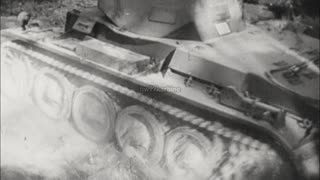Premium Only Content

Fairchild AC-119G Shadow gunship in action over the Ho Chi Minh trail in 1971
The Fairchild AC-119G "Shadow" was a twin-engine piston-powered gunship developed by the United States Air Force during the Vietnam War. It replaced the Douglas AC-47 "Spooky" and operated alongside the early versions of the AC-130 "Spectre" gunship.
By late 1967, the idea of the fixed-wing gunship had been proven so successful, the USAF was having a difficult time keeping up with demand. The newer AC-130s that had been created under Project Gunship II were effective, but were being mostly used for armed reconnaissance and interdiction of the Ho Chi Minh Trail. Furthermore, the C-130 airframe was in active service as a transport, vital to the war effort in Southeast Asia. The Air Force desperately needed a new gunship to replace the vulnerable and underpowered AC-47 in the close air support role, as well as supplementing the AC-130 in attacking targets on the Ho Chi Minh Trail.
The Fairchild C-119 Flying Boxcar presented an obvious choice, having been phased out of front-line service in favor of the C-123 and C-130, and with the stock of available airframes in U.S. Air Force Reserve being sufficient. In February 1968, under the USAF program Project Gunship III, 26 C-119Gs were converted to AC-119G standard, initially taking on the name "Creep", but later assigned the callsign "Shadow".
0:00 An AC-119G, distinguishable from the later K "Stinger" variant by the lack of auxiliary underwing GE J85 turbojets, takes off in the fading light on a truck-hunting mission
0:22 The crew prepare the four GAU-2/A Miniguns for action. The weapons were chambered in 7.62mm NATO and each had a maximum rate of fire of 6,000 rounds per minute, and could be fired individually or in unison. The the latter case that meant the aircraft was firing a total of 400 rounds per second. The SUU-11 gun pods contained up to 2000 rounds but could also be reloaded in flight as can be seen in the footage.
0:37 Unlike the AC-47 it replaced that had to rely on flares to illuminate targets, the AC-119 was fitted with a Night Observation Scope that allowed detection and observation of the enemy while allowing the gunship to remain in the dark. A LAU-74/A flare launcher was however also installed for the sake of tactical flexibility, as well as an AVQ-8 Xenon Light.
0:42 An enemy truck is visible through the NOS and is engaged. While the Miniguns are shown firing, the impacts suggest that this target footage is actually from the later AC-119K variant that was also equipped with a pair of 20mm M61 Vulcan cannon.
At 7,000 foot range, it was determined that the velocity of the 7.62mm bullets dropped from around 2,750 feet per second at the muzzle to around 500 feet per second. With a residual muzzle energy of around 80 ft lbs, this is still more than enough to be lethal against a human target, but was found lacking when it came to hunting trucks. The 20mm cannon were preferred not only because their high explosive rounds were more destructive, but they also allowed the aircraft to operate at higher altitudes where enemy ground fire was less of a threat. In this role the Miniguns were sometimes eliminated altogether in favor of more 20mm ammunition.
Apart from the armament the "Stinger" was also equipped with more sophisticated electronics including the AN/APN-147 Doppler navigation radar, AN/AAD-4 forward looking infrared, AN/APQ-133 side-looking beacon tracking radar and AN/APQ-136 search radar.
By November 1968, the aircraft had deployed to Vietnam and joined the 14th Special Operations Wing at Nha Trang Air Base. The AC-119Gs were placed in the 71st Special Operations Squadron which was formed from the activated 71st Troop Carrier Squadron, of the Air Force Reserve located at Bakalar Air Force Base in Columbus, Indiana. When the 71 SOS returned to continental USA in 1969, the gunships were taken over by the newly formed 17 SOS.
The AC-119Ks were placed in the 18th Special Operations Squadron. With the addition of the two types, the 14 SOW for a time in 1968 was flying eight different aircraft from ten different bases in South Vietnam. The 14 SOW was inactivated in 1971. Limited numbers continued to be operated out of Thailand as late as the fall of 1972, but the AC-119 was phased out shortly after from the US Air Force. The AC-119G and 119K continued to serve with the Republic of Vietnam Air Force until the Fall of Saigon in 1975. During the Vietnam War, only five AC-119 Gunship IIIs were lost to all causes.
If you would like to support the channel consider visiting https://www.buymeacoffee.com/hw97karbine
-
 2:04
2:04
hw97karbine
22 days agoPanzer I and II tanks transported by truck and trailer on maneuvers in 1939
84 -
 5:43
5:43
GritsGG
11 hours agoBest Way To Get Specialist EVERY Game!
5.81K1 -
 1:44:47
1:44:47
Side Scrollers Podcast
18 hours agoKimmel RETURNS + Twitch University + More! | Side Scrollers
36.4K4 -
 13:19
13:19
The Pascal Show
18 hours ago $0.51 earnedCOMEBACK DERAILED! Jimmy Kimmel's Return To Late Night Hit After ABC Affiliates REFUSE To Air Show
4.61K8 -
 LIVE
LIVE
Lofi Girl
2 years agoSynthwave Radio 🌌 - beats to chill/game to
233 watching -
 2:17:05
2:17:05
FreshandFit
6 hours agoFrom SMALLVILLE to AB'SVILLE w/ Sam Jones III
122K7 -
 3:05:45
3:05:45
Price of Reason
12 hours agoTrump's UN Takedown! BACKLASH Over Disney's Jimmy Kimmel Return! Tulsa King Season 3 Premiere Review
128K18 -
 3:03:12
3:03:12
Badlands Media
14 hours agoDEFCON ZERQ Ep. 010: Government Overreach and the Battle for Freedom
174K61 -
 9:46
9:46
Levi
1 day agoWhy XRP's Bull Run Will Be 10x Bigger Than The Last One - Raoul Pal
10.2K2 -
 20:13
20:13
Paul Barron Network
26 days ago $1.19 earnedXRP Vault Yields Coming in September!?🔥Flare CEO INTERVIEW
10.7K1